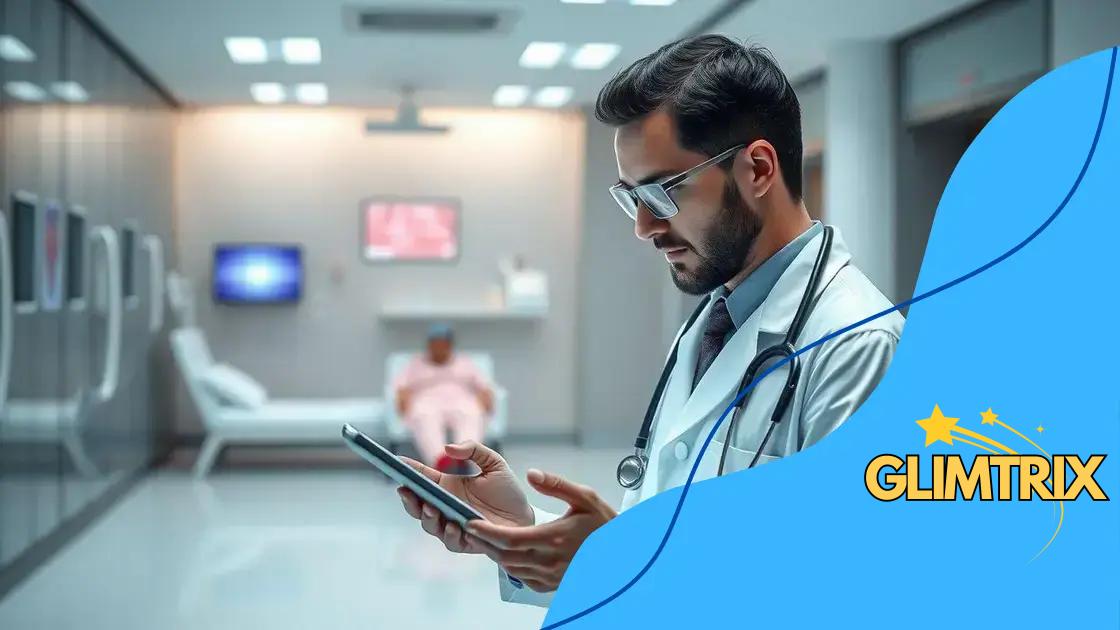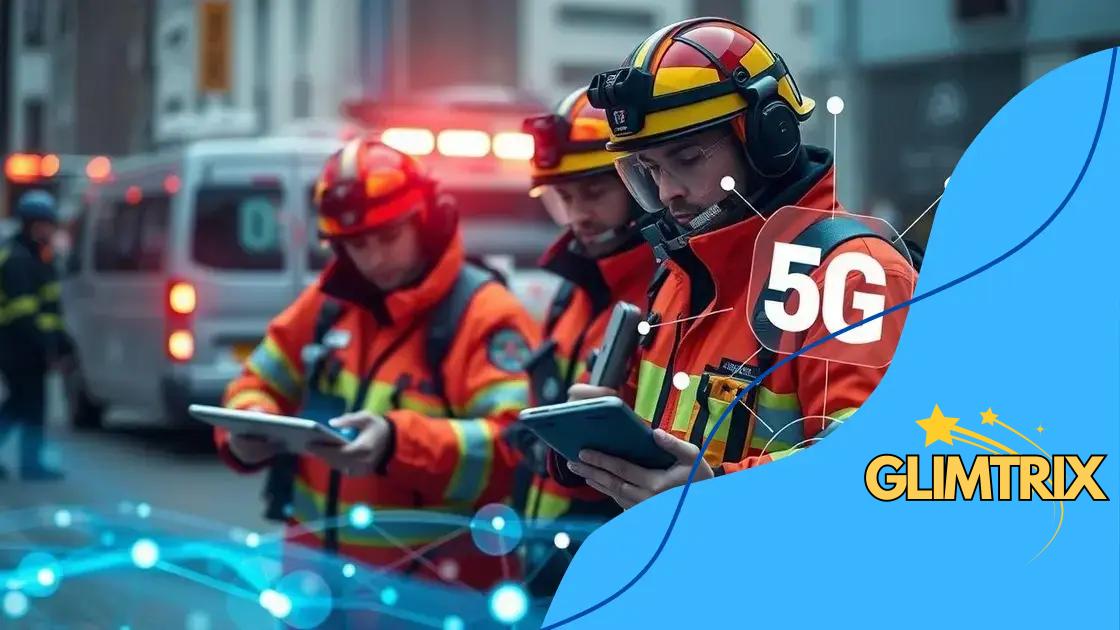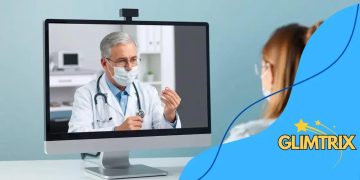5G transforming healthcare accessibility: a game changer

5G transforming healthcare accessibility enhances patient care through faster data sharing, improved communication, and remote monitoring, while also presenting challenges such as infrastructure upgrades and data security concerns.
5G transforming healthcare accessibility is not just a buzzword; it’s a potential revolution in how we view medical services. Imagine accessing vital healthcare from your home or on the go. Curious about how this technology could change your healthcare experience?
Understanding 5G technology
Understanding 5G technology is essential to grasp its impact on various sectors, especially in healthcare. This new generation of wireless technology offers faster speeds and more reliable connections, which are crucial for modern medical practices.
Key Features of 5G Technology
5G is not just about speed; it introduces several remarkable features that enhance performance. Here are some of the key aspects:
- Ultra-fast data rates: 5G can provide speeds up to 100 times faster than 4G.
- Low latency: With latency as low as 1 millisecond, 5G ensures real-time communication, vital in emergency health services.
- Massive connectivity: It can connect millions of devices simultaneously, making it ideal for hospitals and remote patient monitoring systems.
- Enhanced bandwidth: More bandwidth allows for better quality in video consultations and large data transfers.
The transition to 5G opens doors for innovative solutions in healthcare. For example, remote surgeries become feasible as surgeons can operate with minimal delay. This also means that results from diagnostic devices can be sent in real-time to specialists, speeding up decision-making.
Moreover, with the advancement of IoT devices in healthcare, 5G supports a range of applications. These include smart wearables that monitor patient vitals and alert healthcare providers instantly in emergencies. The combination of 5G and IoT creates a network of health management that empowers both patients and professionals.
Impact on Remote Consultations
Imagine a scenario where you can consult a doctor from the comfort of your home without worrying about connectivity issues. This is the reality that 5G brings to remote consultations. The improved speeds and lower latency enable clearer video calls, making the experience more personal and effective.
This technology also expands access to healthcare for individuals in rural areas, where medical facilities may be scarce. With fast internet, patients can engage with healthcare providers without the need to travel long distances, enhancing overall accessibility.
Impact of 5G on remote consultations
The impact of 5G on remote consultations is profound, changing the way healthcare services are delivered. Patients can now connect with healthcare providers from the comfort of their homes, making healthcare more accessible.
Enhanced Communication
One of the most significant benefits is enhanced communication. With 5G, video and audio quality improve drastically, allowing for clearer conversations. This reduces misunderstandings and helps doctors get accurate information about a patient’s condition.
- Real-time feedback: Doctors can review symptoms as they are reported.
- Faster diagnostic processes: Specialists can provide instant input during consultations.
- Improved patient engagement: Clear communications encourage patients to be more involved in their health decisions.
Additionally, this technology allows for more comprehensive virtual consultations. Imagine discussing complex cases with multiple healthcare providers in a single session, all from different locations. This teamwork becomes possible with the reliable connections 5G provides. Patients benefit significantly as they receive holistic care from various specialists without needing to travel.
Broader Access to Specialists
5G facilitates access to specialists who may not be available locally. Patients in rural areas especially benefit from this feature, as they can connect with top-tier doctors in urban centers. The ability to schedule and conduct virtual appointments makes it much easier for patients to receive expert opinions.
In addition, 5G enables remote monitoring of patients with chronic conditions. Wearable devices can transmit vital signs to doctors in real-time. This advancement allows for timely interventions when necessary, leading to better health outcomes.
Through regular monitoring, healthcare providers can adjust treatments as needed, ensuring that patients receive personalized care tailored to their evolving needs. The integration of 5G technology offers an opportunity to enhance both the efficiency and effectiveness of healthcare systems.
Enhancing emergency response with 5G

Enhancing emergency response with 5G technology is transforming how first responders operate in critical situations. The ability to quickly share data can mean the difference between life and death. With faster networks, emergency services can react more effectively and efficiently.
Faster Data Transmission
One key benefit of 5G is its speed, allowing emergency teams to send and receive large amounts of data instantly. This capability helps in various ways:
- Real-time video feeds: Paramedics can send live video of a patient to the hospital while en route, allowing doctors to prepare for treatment.
- Instant communication: Officers can access information about suspects or situations in real time, improving safety during operations.
- Coordinated efforts: Multiple agencies can communicate seamlessly, streamlining responses and minimizing delays.
The impact of 5G also extends to GPS and mapping services, enhancing navigation for emergency vehicles. By providing traffic updates and optimal routes, 5G ensures that responders arrive on scene faster. Imagine an ambulance that can avoid congested routes based on real-time traffic data.
Remote Monitoring and Support
5G can also facilitate remote monitoring of patients during emergencies. Wearable devices can transmit vital signs back to medics, giving them crucial information before they arrive at the hospital. This data can help inform treatment decisions and improve patient outcomes.
Furthermore, 5G allows for the use of augmented reality (AR) in emergency situations. First responders can use AR glasses to receive real-time instructions or overlays on their environment. This technology can guide them through complex scenarios, like search and rescue missions in challenging terrains.
Overall, the integration of 5G into emergency response is paving the way for more informed, quicker, and safer reactions to crises. As this technology continues to evolve, it will enhance the capabilities of first responders, ultimately saving more lives.
Improving patient data management
Improving patient data management with 5G technology is essential for modern healthcare. This innovation allows healthcare providers to manage and share patient information more effectively, which is critical for delivering quality care.
Streamlined Data Sharing
5G enhances how patient data is shared across different systems. With faster connections, doctors and staff can access electronic health records (EHRs) in real-time. This capability means:
- Quick access: Medical professionals can retrieve patient histories instantly when needed.
- Enhanced collaboration: Multiple healthcare providers can view and collaborate on a patient’s data simultaneously.
- Reduced errors: Improved data accuracy lowers the chances of mistakes related to outdated or incomplete information.
Additionally, the ability to transmit large files, such as imaging studies or genetic data, becomes seamless. This feature allows for immediate analysis by specialists, which can lead to quicker diagnoses and treatments. A faster turnaround on test results significantly improves patient care delivery.
Integration of IoT Devices
5G also allows for better integration of Internet of Things (IoT) devices in healthcare. These devices can continuously monitor patient metrics and upload the data instantly. For example, smart wearables can track heart rates or glucose levels and transmit this information to healthcare providers in real time.
This constant flow of data helps in proactive healthcare. By analyzing this information, doctors can customize treatments to fit individual patient needs. If something abnormal occurs, healthcare providers can react quickly, reducing potential complications.
Furthermore, managing patients’ data securely becomes easier with 5G. Enhanced security protocols ensure that sensitive information is protected while being transmitted. This protection fosters trust between patients and healthcare providers.
The combination of 5G technology with improved data management practices leads to smarter healthcare systems. Overall, this advancement helps in delivering better healthcare outcomes and enhances patient satisfaction.
Challenges in implementing 5G in healthcare
Challenges in implementing 5G in healthcare can affect how quickly and effectively this technology improves patient care. While the potential benefits are significant, hurdles must be addressed for successful deployment.
Infrastructure Limitations
One major issue is the need for updated infrastructure. Many healthcare facilities lack the necessary equipment to support 5G networks. This includes:
- Network upgrades: Existing networks may need extensive upgrades to handle increased data loads.
- Cell tower placements: New cell towers must be installed to ensure coverage throughout medical facilities and nearby areas.
- Compatibility with devices: Healthcare devices must be compatible with 5G technology, which may involve additional investments.
Without a solid infrastructure, healthcare providers may struggle to effectively implement 5G technology. This situation can delay the full advantages of improved connectivity and patient care.
Cost Concerns
The financial aspects of implementing 5G can also pose challenges. Hospitals and clinics often operate on tight budgets, making additional expenses difficult to justify. Key cost factors include:
- Investment in new technology: Upgrading or acquiring new devices to leverage 5G capabilities can be expensive.
- Training staff: Training healthcare professionals to effectively use new systems can incur extra costs and requires time.
- Regular maintenance: Ongoing costs related to network maintenance can impact budgets.
Healthcare institutions must carefully assess these financial challenges to avoid compromising patient care or services.
Regulatory and Security Issues
Another significant concern involves regulatory and security aspects. Healthcare data is highly sensitive, and strict regulations govern its storage and sharing. With the integration of 5G, healthcare providers must consider:
- Data security: Ensuring patient data remains secure during transmission is a must.
- Compliance with regulations: Meeting governmental and industry regulations can complicate the implementation process.
- Building trust: Patients must trust that their data will be protected, which can be challenging in a rapidly evolving tech landscape.
Addressing these challenges is crucial. While 5G offers exciting opportunities for healthcare, overcoming the obstacles is necessary to fully realize its potential benefits.
In summary, 5G technology holds great promise for transforming healthcare. With faster data sharing, improved patient management, and enhanced emergency responses, this technology can lead to better health outcomes. However, implementing 5G also presents challenges, including infrastructure needs, costs, and regulatory issues. Addressing these challenges is essential to realize the full potential of 5G in healthcare and to ensure it improves accessibility and quality of care for patients everywhere.
FAQ – Frequently Asked Questions about 5G in Healthcare
What are the main benefits of implementing 5G in healthcare?
5G provides faster data sharing, improved patient management, and enhanced emergency responses, leading to better health outcomes.
What challenges do healthcare providers face when adopting 5G technology?
Challenges include the need for infrastructure upgrades, high costs, and data security concerns that must be addressed for successful implementation.
How does 5G improve emergency response in healthcare?
5G enables real-time data transmission and enhanced communication, allowing first responders to access critical information quickly during emergencies.
Why is data security important when using 5G in healthcare?
Data security is crucial to protect sensitive patient information from breaches, ensuring compliance with regulations and maintaining patient trust.





